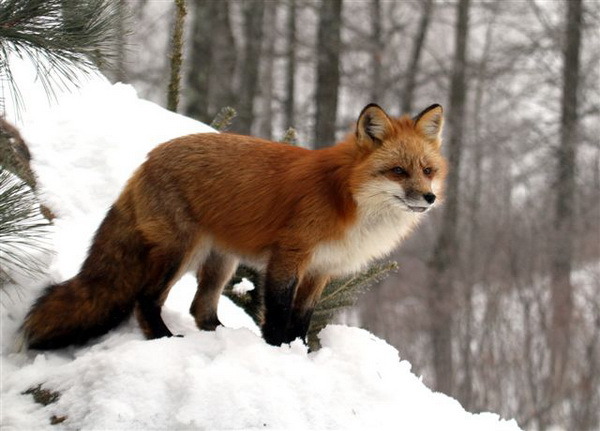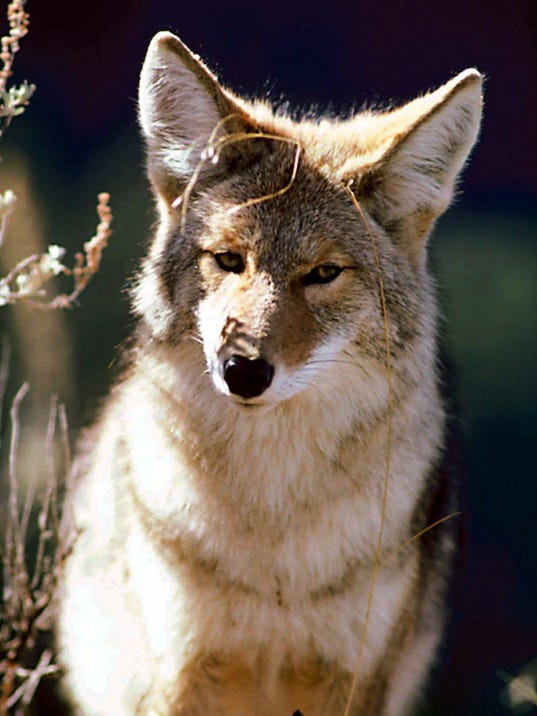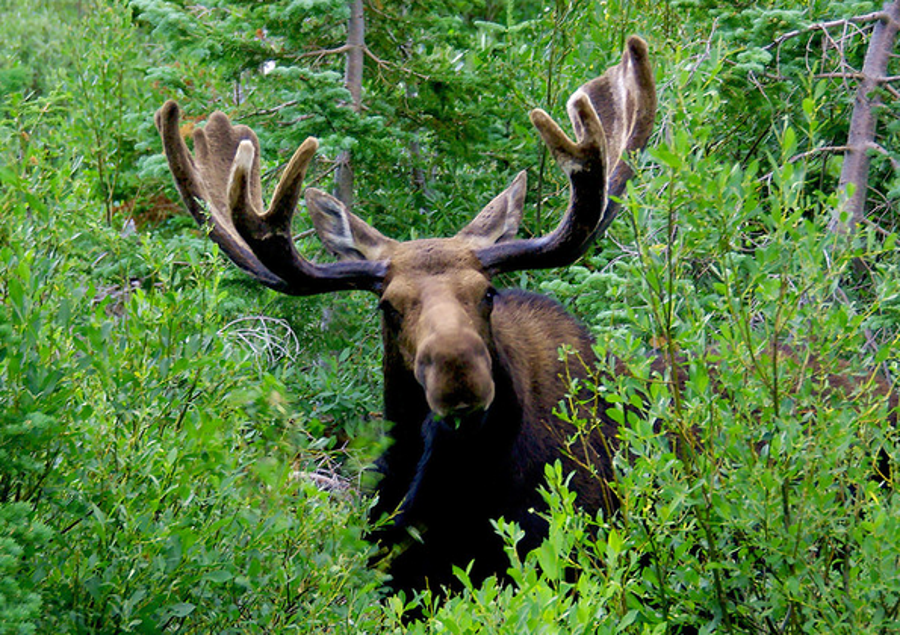Friday, Jul 14, 2017
By Eugene Kutz, MNA Intern
The Michigan Nature Association is recognizing 2017's Michigan Mammals Week July 10-16 and wishes to highlight some of our favorite species living in the Great Lakes State.
Take a quick inventory and marvel at Michigan's various mammals, from bats to bears! Summer is a great time to plan outdoor adventures in the state of Michigan and one of the best times to observe the abundance of mammals found at MNA sanctuaries! Will you encounter a great Michigan mammal this summer?
We encourage you to check out our list of MNA sanctuaries specially selected for their seasonal offerings to those looking to enjoy opportunities in Michigan's great outdoors.
MICHIGAN BATS

Bats are as misunderstood as they are intriguing. They are the only mammals capable of sustained flight. A bat's wing is unique because unlike wings of birds and insects, it's actually skin stretched over long, thin fingers which can connect the arms and legs and even the tail. Adapted to flying at night, bats can nagivate in total darkness, famous for their use of echolocation. By creating high-frequency sound pulses that bounce off nearby objects, bats use the returning echoes to determine an object's size, shape and distance. This technique all but gives away the location of prey while guiding bats' aerial movements.
Michigan bats diet consists of a variety of moths, flies, beetles and other insects, and can capture up to 1,000 mosquito-sized insects per hour. Bats mostly live in forests that are situated near water, where insects thrive.
In winter months, bats have adapted to hibernate due to the lack of insects to hunt. Although some bats migrate to warmer regions, many can hibernate in the numerous caves and mines throughout Michigan.
More info: http://www.michigan.gov/dnr/0,4570,7-153-10370_12145_12205-70016--,00.html
Explore the bats native to Michigan:
- Little Brown Bat
- Northern Long-eared Bat
- Evening Bat
- Hoary Bat
- Big Brown Bat
- Tri-colored Bat
- Indiana Bat
- Silver-haired Bat
- Red Bat
MICHIGAN BLACK BEARS
The only species of bear found in Michigan - the black bear - is mostly found in western North America. The black bear moniker is mostly deserved, with most sporting black or dark brown fur, but the black bear's fur can actually vary from browns to blondes to gray-blues.
On all fours, adults reach nearly three feet tall, spanning 3-5 feet in length. Adult females average smaller than males, weighing up to 300 pounds with adult males weighing up to 500 pounds! Adult males and females share company during breeding seasons, but are otherwise solitary creatures after mothers have reared their cubs.
During their seasonal retirement, Michigan black bears drop their body temperature by just a few degrees, and because of this are not true hibernators, as a hibernating animal's body temperature will level with the temperature of its environment. For this reason, bears can be awakened easily during their denning period and will flee right away when feeling threatened.
They typically enter their dens in December, emerging in early-to-mid-spring. Dens are made in rock cavities, root masses, standing trees, openings under fallen trees or as excavated or constructed ground nests. Cubs are usually born in January and without their fur, rely heavily on their mother. Yet they grow quickly, reaching up to 60 pounds by the end of their first summer and staying with their mother until they're a year and a half old and may enjoy a lifespan of over 30 years.
Michigan's black bears are often found in heavily forested areas, but also reside in deciduous lowlands, uplands, and coniferous swamps. They continue moving into the southern Lower Peninsula but inhabitat a variety of landscapes, rotating habitats with seasonal availability of food.
The size of a bear's "home-range" in which it resides varies with its sex and age. Mothers of newborn cubs stay within smaller home-ranges of about 50 square miles which gradually increase as their cubs grow up, while male home-ranges average 335 square miles, generally overlapping with other bears.
As omnivores, black bears are opportunistic feeders, using both plant and animal matter and feed heavily in the fall to store fat for winter. They feed on wetland vegetation in the spring and fruits and berries in summer and fall, the majority of animal matter consumed consisting of insects and larvae. Yet bears are capable of preying on most small to medium-sized animals, even acquire foods from humans, such as fruit and vegetable crops, apiaries, bird feed and garbage, with human activity factoring into a bear's choice of home-range.
More info: http://www.michigan.gov/dnr/0,1607,7-153-10363_10856_57530---,00.html
Explore more fascinating information on the black bears of Michigan:
MICHIGAN FLYING SQUIRRELS

Michigan's most elusive mammal, the flying squirrel can be found throughout the state, yet a few people have had the opportunity to view them. Entirely nocturnal, Michigan is home to two species of flying squirrels: the northern flying squirrel inhabits the northern Lower and Upper Peninsulas, while the southern flying squirrel inhabits the southern Lower Peninsula.
Flying squirrels inhabit forests, parks and other woodlands, nesting in summer and denning in winter in the cavities of mature trees.
Although their aerial maneuverability is certainly impressive, unlike Michigan bats, flying squirrels are not actually capable of flight. Instead, they are equipped with loose, furry skin attached between their front and back legs, helping them glide between the trees of their wooded homes.
For a chance to see these creatures after dark, the Michigan DNR suggests using a red light to illuminate bird feeders. You may just spot a Michigan flying squirrel having a midnight meal! The red light won't bother feeding squirrels, and allows you to see their activity after dark.
Although populations remain large, the northern flying squirrel is no longer being found in their historic ranges, while researchers record higher numbers in areas previously uninhabited by them. Researchers have found evidence suggesting the flying squirrel populations are at risk in the northern region of the Lower Peninsula, studying why flying squirrel populations in the north are decreasing while southern populations are increasing.
Michigan State University researchers are attempting to map the ranges of the two species for comparison to historical information, as part of a project funded by the Nongame Wildlife Fund.
More info: http://www.michigan.gov/dnr/0,4570,7-153-10370_12145_12205-32998--,00.html
MICHIGAN WOLVES

The return of wolves in Michigan is a story of successful wildlife recovery. State and federal protection of wolves enabled the comeback of the species throughout the western Great Lakes region. In Michigan, wolves eat deer, beaver, rodents and other small mammals, but also snack on insects, nuts, berries and grasses. They are the only Canid species in Michigan that hunts in a social unit (the pack) and although wolves can go for a week without eating, when they do eat, their meal may include 20 pounds of meat at a time.
The largest member of the Canid family (wild dogs), wolves are native to Michigan and were once present in all 83 counties. Yet persecution and active predator control programs throughout the 20th century virtually eliminated wolves from Michigan, and by 1840, they could no longer be found in the southern portion of the Lower Peninsula. By 1935, they had completely disappeared from the Lower Peninsula, and had nearly vanished from the Upper Peninsula by 1960, when a state-paid bounty on wolves was finally repealed.
Pictured Rocks National Lakeshore was home to the last known pups born during this era, and the species remained unprotected in Michigan until the state Legislature granted full legal protection in 1965. It was then that the federal government listed the gray wolf as endangered under the Endangered Species Act (ESA) in 1973, at a time when Michigan's wolf population was estimated at only six animals in the U.P., along with an isolated population on Isle Royale.
And it just so happened then in the 1970s an increasing number of wolf sightings and occasional encounters with motorists in the U.P. were reported. An attempt at translocating four wolves from Minnesota to the U.P. was made in 1974, but all four animals were killed by humans within eight months, before any successful reproduction could occur. The DNR subsequently decided to let wolf recovery happen naturally without human intervention.
Natural emigration of wolves from Minnesota, Ontario and Wisconsin to the Upper Peninsula was first documented in the 1980s, when a pair of wolves was discovered in the central U.P. The pair had pups in 1990, and by 1992, when the population numbered an estimated 21 animals, it was clear wolves were starting to successfully rebound in the state, particularly in the U.P. due to the availability of prey and timber harvesting practices that created a prime habitat for deer.
Through continued extensive conservation efforts over the following years, the Michigan/Wisconsin combined population currently numbers a more remarkable 1,000 wolves. In light of this significant recovery of the wolf population, the state Legislature removed wolves from the state list of endangered species in April 2009, and reclassified wolves as a protected, nongame species. But in January 2012, wolves were removed by the U.S. Fish & Wildlife Service in Michigan, Wisconsin and Minnesota from the federal endangered species list and returned management authority to the state level. Yet in December 2014, a federal court order returned wolves to the Federal Endangered Species list. An appeal of this decision is ongoing.
A large part of the recovery success story is also attributed to support from the public. Survey results from the mid-1990s, when wolves first began to rebound in the U.P., supported wolf recovery. Continued social acceptance of a self-sustaining wolf population is critical to maintaining the population's "recovered" status and retaining state management authority.
More info: http://www.michigan.gov/dnr/0,4570,7-153-10370_12145_12205-32569--,00.html
MICHIGAN RED FOX

Every county in Michigan is home to red foxes! They're highly mobile mammals, hunting alone and making shelter in fields, meadows, streams, low bush, and shrub cover and along woods and beaches. Yet you may find a red fox in your backyard; or wherever it might look for an unwanted snack!
Red foxes are members of the Canidae (dog) family, are opportunistic eaters, making a meal out of nearly anything available. They will eat insects, plants, fruits, berries, seeds, or birds, frogs and even snakes. They may also eat small mammals such as mice, rabbits, and squirrels, but could grab a bite to eat in garden vegetables, garbage or pet foods. Some foxes may cause a problem if they lose their fear of humans and learn to kill small farm animals like chickens, and so steps should be taken to ensure foxes or other wild animals are not fed by humans.
A primarily nocturnal mammal, red foxes are most active at night, commonly spotted at early morning or late evening. However, you could stumble upon a red fox during the day, especially in open areas - but from a distance, their sleek physique may have you second guessing if you saw a cat!
They may look familiar to your dog, but slender and smaller, with long, bushy tails over two feet long. Because their fur makes them look bigger, red foxes are lighter then they may appear. The titular red color accents their faces and tops of their heads, with orange or yellow fur on their necks. Their white-tipped tails are outlined with black fur, as well as their ear tips. A red fox is gloved with dark black or brown paws, while the insides of their ears, chest, and belly are creamy white.
A fox likes to make its shelter in well-drained, dry areas, and can be found in the middle of fields, on woodland edges, ridges, or any place which provides shelter. Fox families burrow in the ground to make a den with two entrances, usually by excavating old woodchuck or badger holes. This place is where they can safely raise their young, and if they wish, share their den with a second family.
More info: http://www.michigan.gov/dnr/0,4570,7-153-10370_12145_12205-61328--,00.html
MICHIGAN COYOTE

Coyotes are found throughout Michigan and have dispersed into southern Michigan without assistance from the DNR. Coyotes are found in rural to urban areas and are quite common but extremely good at remaining unnoticed by humans, even while living in close proximity.
Coyotes can be difficult to distinguish from a medium sized German shepherd dog from a distance. There is wide variation in the coyote's color, but generally their upper body is yellowish gray, and the fur covering the throat and belly is white to cream color. The coyote's ears are pointed and stand erect, unlike the ears of domestic dogs that often droop. When observed running, coyotes carry their bushy, black tipped tail below the level of their back, in comparison to wolves that carry their tail in a horizontal position while running.
This member of the dog family is extremely adaptable and survives in virtually all habitat types common in Michigan. They are most abundant in areas where adequate food, cover, and water are available. The size of a coyote's home range depends on the food and cover resources available and on the number of other coyotes in an area, but it generally averages between 8 and 12 square miles. Mated pairs and 4 to 7 pups occupy the home range during the spring and summer seasons in Michigan.
People are most likely to see coyotes during their breeding period, which occurs in Michigan fom mid-January into March. As fall approaches, pups begin dispersing from the den site to establish home ranges of their own. These young dispersing animals sometimes wander into urban areas. Coyotes are active day and night; however, peaks in activity occur at sunrise and sunset. Coyotes generally feed at night. They are opportunistic and will eat almost anything available. Small mammals such as mice, voles, shrews, rabbits, hares, and squirrels are preferred foods, but will also eat fruits, plants, birds, and snakes. In urban areas, coyotes are attracted to garbage, garden vegetables, and pet foods.
More info: http://www.michigan.gov/dnr/0,4570,7-153-10370_12145_12205-60378--,00.html
MICHIGAN MOOSE

Moose are native to Michigan and occurred throughout nearly the entire state prior to European settlement. Moose disappeared from the Lower Peninsula in the 1890s, and only a few scattered individuals remain in the Upper Peninsula.
Moose are the largest members of the deer family and the tallest mammal in North America ranging from 5-7 feet. Their massive bodies can weigh up to 725 to 1,100 pounds! The moose's coloration can vary from grayish- or reddish-brown to the occasional all-black individual.
Since moose prefer colder climates, they only live in areas that have seasonal snow cover. Boreal forests with shrubby growth and immature trees along the cedar swamps, marshes, and alder-willow thickets near waterways are popular places to find moose.
Moose is an Algonquin term that means "twig eater". They tend to graze on leaves, bark, pine cones, twigs, and buds of aspen, maple, and birch trees and shrubs. They also eat aquatic plants like water lilies, rushes, arrowheads, and horsetails.
More info: http://www.michigan.gov/dnr/0,1607,7-153-10370_12145_58476---,00.html
MICHIGAN COUGAR

Michigan cougars, also called mountain lions, were originally native to Michigan, but were extirpated from Michigan around the turn of the century. Over the past few years, numerous cougar sighting reports have been received from various locations throughout the state. Today the species in Michigan is listed as endangered and is protected under state law.
Cougars are the second largest cat in North America - they vary between 5-9 feet long and can weigh up to 150-200 pounds. Unlike other big cats; however, the cougar cannot roar. Instead, the large feline purrs like a house cat.
Inhabiting various ecosystems from mountains to deserts to sea-level, they make their home anywhere there is shelter and prey. Cougars are primarily nocturnal although they can be active during the day. They are solitary and secretive animals that prefer to hunt from cover. Generally they prey on deer but also feed on smaller animals if necessary, including domestic animals and livestock. Cougars have even been known to eat insects.
More info: http://www.michigan.gov/dnr/0,1607,7-153-10370_12145_43573---,00.html
Check out the Michigan DNR website to find programs near you celebrating and teaching about Michigan's great mammals, with activities like hikes, animal tracking programs, and more.


Laura